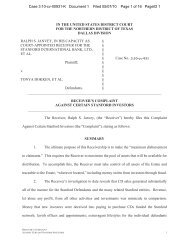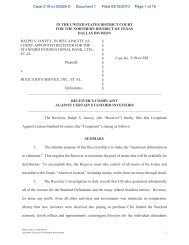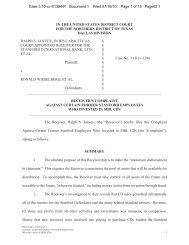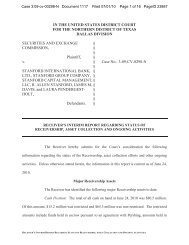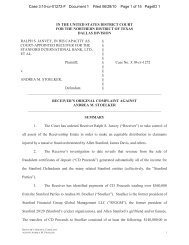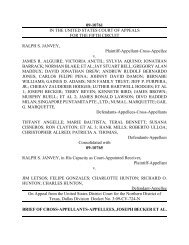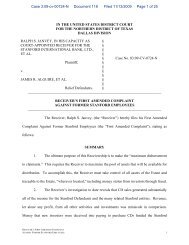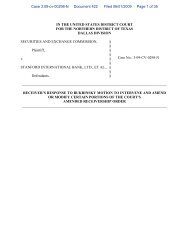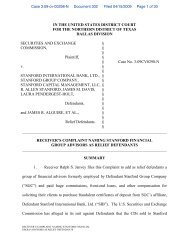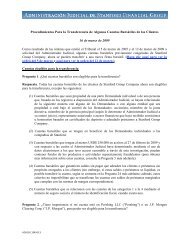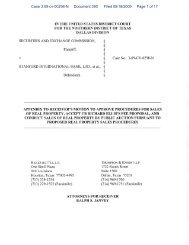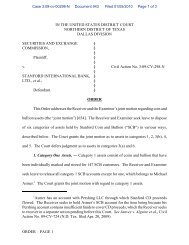Receiver's Additional Complaint Against Certain Investors - Stanford ...
Receiver's Additional Complaint Against Certain Investors - Stanford ...
Receiver's Additional Complaint Against Certain Investors - Stanford ...
You also want an ePaper? Increase the reach of your titles
YUMPU automatically turns print PDFs into web optimized ePapers that Google loves.
Case 3:10-cv-00725-P Document 1 Filed 04/08/2010 Page 8 of 16<br />
the Receivership Estate.”<br />
Order Appointing Receiver (Doc. 10) at 4; Amended Order<br />
Appointing Receiver (Doc. 157) at 4. Paragraph 5(c) of the Order specifically authorizes the<br />
Receiver to “[i]nstitute such actions or proceedings [in this Court] to impose a constructive trust,<br />
obtain possession, and/or recover judgment with respect to persons or entities who received<br />
assets or records traceable to the Receivership Estate.” Order Appointing Receiver (Doc. 10) at<br />
5(c); Amended Order Appointing Receiver (Doc. 157) at 5(c).<br />
28. One of the Receiver’s key duties is to maximize distributions to defrauded<br />
investors and other claimants. See Amended Order Appointing Receiver (Doc. 157) at 5(g), (j)<br />
(ordering the Receiver to “[p]reserve the Receivership Estate and minimize expenses in<br />
furtherance of maximum and timely disbursement thereof to claimants”); Scholes v. Lehmann, 56<br />
F.3d 750, 755 (7th Cir. 1995) (receiver’s “only object is to maximize the value of the [estate<br />
assets] for the benefit of their investors and any creditors”); SEC v. TLC Invs. & Trade Co., 147<br />
F. Supp. 2d 1031, 1042 (C.D. Cal. 2001); SEC v. Kings Real Estate Inv. Trust, 222 F.R.D. 660,<br />
669 (D. Kan. 2004). But before the Receiver can attempt to make victims whole, he must locate<br />
and take exclusive control and possession of assets of the Estate or assets traceable to the Estate.<br />
Doc. 157 5(b).<br />
29. The <strong>Stanford</strong> <strong>Investors</strong> named in the Appendix received money that they may<br />
have believed was a return on an investment placed with what they thought was a legitimate<br />
bank. In reality, the money the <strong>Stanford</strong> <strong>Investors</strong> received was not their money, was not a<br />
return on their investments, and was not generated by any of SIBL’s other business ventures.<br />
The CD Proceeds were simply money that came from the more than 20,000 CD holders who<br />
were deceived into purchasing CDs and who by chance, or as the result of sales tactics by<br />
<strong>Stanford</strong> financial advisors and other employees, had not withdrawn funds from SIBL as of the<br />
RECEIVER’S COMPLAINT<br />
AGAINST CERTAIN STANFORD INVESTORS 8



